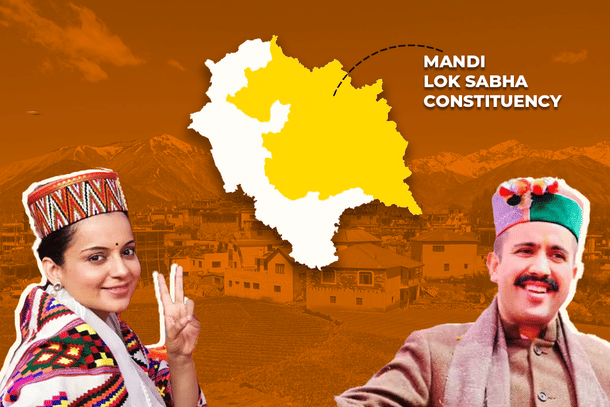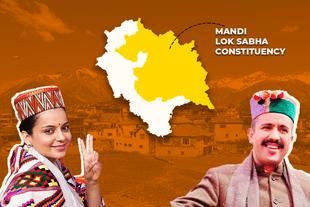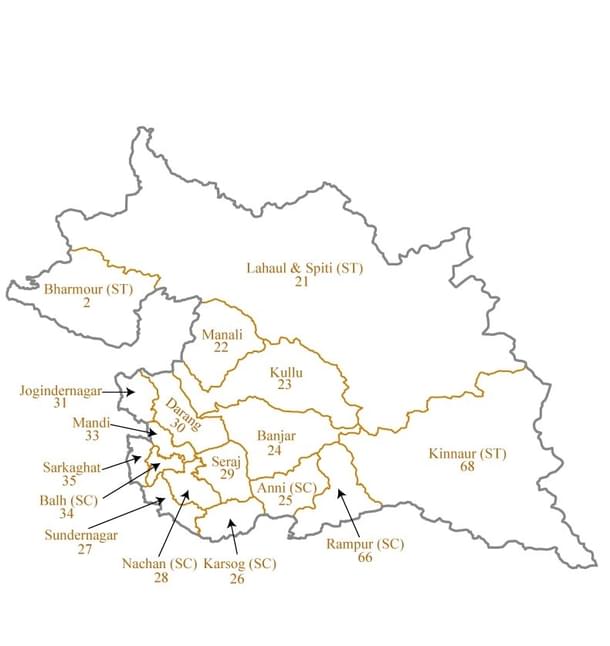Ground Reports
Border Villages Of Himachal Want To Vote For 'Nation First' — Ground Report From Remote Parts Of Mandi Lok Sabha Constituency
Ankit Saxena
May 30, 2024, 01:53 PM | Updated 01:53 PM IST
Save & read from anywhere!
Bookmark stories for easy access on any device or the Swarajya app.


From the busy mountain towns like Mandi, Rampur Bushahr, Kullu and Manali, to the remotest villages in Kinnaur, Lahaul and Spiti, the Mandi constituency in Himachal Pradesh showcases a vibrant cultural landscape shaped by its diverse geography.
For many of these villages, perched above 10,000 feet from sea level, what makes it special is the awareness and considerations within these small communities, each with their own set of concerns and opinions.
As the largest constituency in the state, the Mandi Lok Sabha seat includes 17 legislative assembly segments spread across six districts — Mandi, Kullu, Shimla, Chamba, Lahaul and Spiti, and Kinnaur.

The constituency not only reflects geographic and cultural diversity but also presents an interesting political landscape.
It is here, that Bollywood actress Kangana Ranaut from Bharatiya Janata Party (BJP) is contesting against Congress’s Vikramaditya Singh, heir of the Bushahr royal family and son of six-time former chief minister Virbhadra Singh.
Historically, the Mandi constituency has favoured scions of erstwhile princely states, electing royals in 13 out of 19 elections.
Over the past two decades, the political landscape has seen significant shifts. In 2004, Congress candidate Pratibha Singh defeated Maheshwar Singh of the BJP, and in 2009, Congress’s Virbhadra Singh narrowly defeated Maheshwar Singh.
However, in 2014, amid the Narendra Modi-led BJP wave, Ram Swaroop Sharma from the BJP defeated Pratibha Singh and further retained the seat in 2019. After Sharma’s sudden death in March 2021, the seat fell vacant, leading to Pratibha Singh winning the by-election against BJP’s Khushal Thakur.
Looking ahead to 2024, many on the ground believe the BJP will sweep all four seats. However, with Singh and Ranaut competing against each other, the election has become highly captivating in this parliamentary constituency.
The Busy Mountain Towns Of Mandi
Mandi is the ancestral seat of Congress candidate Vikramaditya Singh’s father, former chief minister Virbhadra Singh.
Congress has won this seat 12 times since 1952, with his family alone holding it for six terms. Vikramaditya’s mother, Pratibha Singh, is the current MP, clearly showcasing their dominance in the region.
“This is the gaddh (base) for the royal family,” says a government employee working in a state-run facility in Rampur Bushahr. The town serves as the hub for several rural and remote regions further north.
“Here, especially in this region, it remains a tough fight for any candidate of the BJP. Many people have fixed votes for the royal family and the party. Any other concern or reason does not matter. It will be 65-35 per cent for Congress and BJP here, respectively,” he adds.
In contrast, Ranaut has no family lineage or political experience. Hence, many believe that in these regions, the BJP's success relies not on the candidate, but on the strength of the Narendra Modi factor, which still stands strong.

Moving forward, in Jeori and Reckong Peo towns, still placed in the Congress belt, the Modi wave continues to influence.
The 62-year-old Panna Ram Negi tells Swarajya, “Simply put, this area has seen more development during Modi's tenure. Not only the towns, but all roads connecting surrounding villages have been developed. This progress has been done in the last 5-6 years, under the PM Gramin Sadak Yojana.”
“There are villages here, with populations ranging from 500 to 600. Most of the people are engaged in horticulture. Until a few years ago, there were no roads connecting them for travel and trade. Under the scheme, there is a good budget. Gaon gaon tak sadak pahuch chuki hai (roads have reached every village)."
He mentions that one of his sons is an assistant professor at Leh University, while the other son will soon be joining the Intelligence Bureau.
“Previously, there was dhandlebaaji (corruption) involved in all government job selections. Now, it is all regulated and organised digitally. Himachal mein humesha paisa leke kaam hota tha, ab sab badal gaya. Aapke yogyata pe selection hota hai (In Himachal, there was always bribery involved, but now everything has changed. Selections are based solely on merit)”, he adds.



Another local farmer adds, “People keep complaining about inflation, but that's happening everywhere. The Centre has to run the country. I believe that those who work hard don't feel the pinch of rising prices. Only those who want handouts and depend on welfare keep complaining.”
He adds, “Many don’t want to change their opinion. They keep complaining about not getting personal benefits, but they need to recognise the development happening at the community and regional levels. Roads are built, our produce is reaching markets. All of this is also development supported by the Centre.”
Country’s Highest Villages To Vote At 12,000 Feet
Beyond the busy mountain towns, the Mandi seat also includes a series of pristine villages in Kinnaur, and Lahaul and Spiti, which share a 220 km stretch of the India-Tibet border.
Most of these villages are situated at altitudes above 10,000 feet, with populations ranging from 500 to 1,000. This also includes the world's highest polling station, Tashigang, at 15,256 feet above sea level, in the Lahaul-Spiti district, near Nako village.
These settlements have existed in isolation for years, nurturing their own distinct cultures and traditions. Now, with access to roads, telephone, and Internet connectivity, it is fascinating to observe the interest and awareness among these people as they eagerly await to exercise their voting rights.
In the small village of Tabo, associated with Buddhism and known for its heritage monastery, locals are highly aware of their candidates and the political dynamics, not just within the state, but throughout the country.
“It is a contest between the prince and the queen,” adds Gopal Negi, a shopkeeper in Tabo. “Everyone is going to vote here. It's our duty. But I cannot tell you who holds the upper hand. The queen will return to Mumbai. The prince may stay in Himachal Pradesh. That's what the people here are thinking.”

.jpeg?w=610&q=75&compress=true&format=auto)

Further, in the last villages along this border, where better road access is still a work in progress, there is a strong sense of voting for the nation first. Same is the sense in Rakchham village, with a population of 597, which stands as the second last village from the border, before Chitkul.
“We will vote for Modi! Nation first!” asserts Mahesh Negi from the village.
When asked about the candidates, he adds, “The Congress candidate is strong. But for the BJP, it is not about the candidate. She is a dancer. Our vote will go only for Modi Ji. You look at the progress here. These remote regions have never received such attention before.”
“Tourism has increased, our shops have work. The roads have made our villages accessible to the country. Earlier it used to take 2 days to reach Rampur and 3 days to reach Shimla. This development is happening to keep the nation together,” he adds.



.jpeg?w=610&q=75&compress=true&format=auto)
For many in these remote villages, situated along the border with Tibet and distant from mainstream civilisation, the upcoming elections revolve largely around the maximum progress in basic connectivity with the development of roads, economic growth through tourism, and the horticulture trade.


.jpeg?w=610&q=75&compress=true&format=auto)
However, their current expectations from the government now are directed towards essential services such as more schools, colleges, and accessible healthcare facilities within their villages.
Additionally, they seek further attention on improving water supply and electricity infrastructure, particularly crucial during the harsh winter months that these settlements face annually.
This report is part of Swarajya's 50 Ground Stories Project - an attempt to throw light on themes and topics that are often overlooked or looked down. You can support this initiative by sponsoring as little as ₹2999. Click here for more details.





